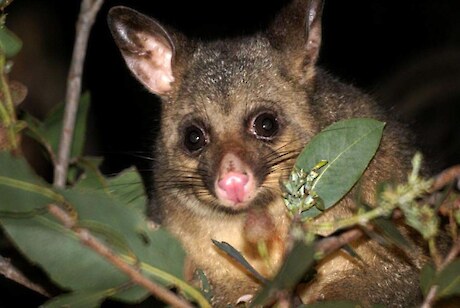 Possums just love the succulent leaves, buds and flowers of the New Zealand bush. One possum eats around 3.5kg per night, depriving our native birds of the berries and nectar they need. But possums don’t just devastate the foliage, they also eat eggs, chicks, insects and snails. And they spread bovine tuberculosis in cattle.
Possums just love the succulent leaves, buds and flowers of the New Zealand bush. One possum eats around 3.5kg per night, depriving our native birds of the berries and nectar they need. But possums don’t just devastate the foliage, they also eat eggs, chicks, insects and snails. And they spread bovine tuberculosis in cattle.
In short, possums don’t belong here. The Australian common brushtailed possum (Trichosurus vulpecula) was introduced to isolated spots around Aotearoa in the 1850s with the intention of starting a fur trade. They quickly escaped (or were released) and spread to almost every part of the country. By the 1980s we had up to 70 million of them, and though possum control has halved that number there is still lots of work to do. Check out some interesting facts here.
Aotea (Great Barrier), Hauturu (Little Barrier), Waiheke and many smaller islands around Auckland have always remained possum-free, and possums have been eradicated from Rangitoto, Motutapu and Tiritiri Matangi. In suburban Auckland they’re still abundant, browsing your trees, eating your fruit and seriously impacting native biodiversity. Fortunately, urban trees are accessible and trapping is effective. With a bit of effort, eliminating possums from inner west Auckland seems a very achievable target.
 Trapping possums
Trapping possums
Historically, hunting has been a successful (and sometimes profitable) way of controlling possum numbers in the bush. This isn’t appropriate in a suburban setting, and isn’t successful once numbers are low – which is what we’re aiming for.
Across the Urban Ark area, Auckland Council contractors lay bait for possums in many of the larger reserves. This helps keeps numbers down, but often works best when supplemented by trapping.
If you’ve got a problem with possums in your area we’d love to help. The Urban Ark tool library has a number of Trapinator possum traps which can be deployed for a few weeks to knock back the numbers. For larger infestations, we can help set up a permanent possum trapline.
The best approach is to join your local group, and check out our Trapping Resources pages for more information, particularly on:
- setting a Trapinator possum trap
- which lures to use to attract possums to your trap
- how to blaze the tree to provide a visual attractant
- keeping tabs on numbers by recording your catch
- how to dispose of your catch
